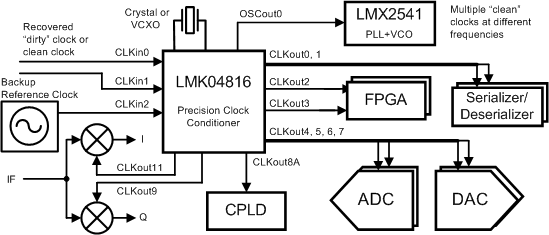ZHCSEI4C July 2012 – January 2016 LMK04816
PRODUCTION DATA.
- 1 特性
- 2 应用
- 3 说明
- 4 修订历史记录
- 5 Pin Configuration and Functions
- 6 Specifications
- 7 Parameter Measurement Information
-
8 Detailed Description
- 8.1
Overview
- 8.1.1 System Architecture
- 8.1.2 PLL1 Redundant Reference Inputs (CLKin0/CLKin0*, CLKin1/CLKin1*, and CLKin2/CLKin2*)
- 8.1.3 PLL1 Tunable Crystal Support
- 8.1.4 VCXO and CRYSTAL-Buffered Outputs
- 8.1.5 Frequency Holdover
- 8.1.6 Integrated Loop Filter Poles
- 8.1.7 Internal VCO
- 8.1.8 External VCO Mode
- 8.1.9 Clock Distribution
- 8.1.10 0-Delay
- 8.1.11 Default Start-Up Clocks
- 8.1.12 Status Pins
- 8.1.13 Register Readback
- 8.2 Functional Block Diagram
- 8.3
Feature Description
- 8.3.1 Serial MICROWIRE Timing Diagram
- 8.3.2 Advanced MICROWIRE Timing Diagrams
- 8.3.3 Inputs and Outputs
- 8.3.4 Input Clock Switching
- 8.3.5 Holdover Mode
- 8.3.6 PLLs
- 8.3.7 Status Pins
- 8.3.8 VCO
- 8.3.9
Clock Distribution
- 8.3.9.1 Fixed Digital Delay
- 8.3.9.2
Clock Output Synchronization (SYNC)
- 8.3.9.2.1 Effect of SYNC
- 8.3.9.2.2 Methods of Generating SYNC
- 8.3.9.2.3 Avoiding Clock Output Interruption due to SYNC
- 8.3.9.2.4 SYNC Timing
- 8.3.9.2.5
Dynamically Programming Digital Delay
- 8.3.9.2.5.1 Absolute versus Relative Dynamic Digital Delay
- 8.3.9.2.5.2 Dynamic Digital Delay and 0-Delay Mode
- 8.3.9.2.5.3 SYNC and Minimum Step Size
- 8.3.9.2.5.4 Programming Overview
- 8.3.9.2.5.5 Internal Dynamic Digital Delay Timing
- 8.3.9.2.5.6 Other Timing Requirements
- 8.3.9.2.5.7 Absolute Dynamic Digital Delay
- 8.3.9.2.5.8 Relative Dynamic Digital Delay
- 8.3.10 0-Delay Mode
- 8.4 Device Functional Modes
- 8.5 Programming
- 8.6
Register Maps
- 8.6.1 Register Map and Readback Register Map
- 8.6.2 Default Device Register Settings After Power On Reset
- 8.6.3
Register Descriptions
- 8.6.3.1
Registers R0 to R5
- 8.6.3.1.1 CLKoutX_Y_PD, Powerdown CLKoutX_Y Output Path
- 8.6.3.1.2 CLKoutX_Y_OSCin_Sel, Clock group source
- 8.6.3.1.3 CLKoutY_ADLY_SEL[29], CLKoutX_ADLY_SEL[28], Select Analog Delay
- 8.6.3.1.4 CLKoutX_Y_DDLY, Clock Channel Digital Delay
- 8.6.3.1.5 RESET
- 8.6.3.1.6 POWERDOWN
- 8.6.3.1.7 CLKoutX_Y_HS, Digital Delay Half Shift
- 8.6.3.1.8 CLKoutX_Y_DIV, Clock Output Divide
- 8.6.3.2 Registers R6 TO R8
- 8.6.3.3 Register R10
- 8.6.3.4 Register R11
- 8.6.3.5 Register R12
- 8.6.3.6 Register R13
- 8.6.3.7 Register 14
- 8.6.3.8 Register 15
- 8.6.3.9 Register 16
- 8.6.3.10 Register 23
- 8.6.3.11
REGISTER 24
- 8.6.3.11.1 PLL2_C4_LF, PLL2 Integrated Loop Filter Component
- 8.6.3.11.2 PLL2_C3_LF, PLL2 Integrated Loop Filter Component
- 8.6.3.11.3 PLL2_R4_LF, PLL2 Integrated Loop Filter Component
- 8.6.3.11.4 PLL2_R3_LF, PLL2 Integrated Loop Filter Component
- 8.6.3.11.5 PLL1_N_DLY
- 8.6.3.11.6 PLL1_R_DLY
- 8.6.3.11.7 PLL1_WND_SIZE
- 8.6.3.12 Register 25
- 8.6.3.13 Register 26
- 8.6.3.14 Register 27
- 8.6.3.15 Register 28
- 8.6.3.16 Register 29
- 8.6.3.17 Register 30
- 8.6.3.18 Register 31
- 8.6.3.1
Registers R0 to R5
- 8.1
Overview
-
9 Application and Implementation
- 9.1
Application Information
- 9.1.1 Loop Filter
- 9.1.2 Driving CLKin and OSCin Inputs
- 9.1.3 Termination and Use of Clock Output (Drivers)
- 9.1.4 Frequency Planning With the LMK04816
- 9.1.5 PLL Programming
- 9.1.6 Digital Lock Detect Frequency Accuracy
- 9.1.7 Calculating Dynamic Digital Delay Values for Any Divide
- 9.1.8 Optional Crystal Oscillator Implementation (OSCin and OSCin*)
- 9.2 Typical Application
- 9.3 System Examples
- 9.1
Application Information
- 10Power Supply Recommendations
- 11Layout
- 12器件和文档支持
- 13机械、封装和可订购信息
1 特性
- 超低均方根 (RMS) 抖动性能
- 100fs RMS 抖动(12kHz 至 20MHz)
- 123fs RMS 抖动(100Hz 至 20MHz)
- 双环 PLLATINUM™锁相环 (PLL) 架构
- PLL1
- 集成低噪声晶体振荡器电路
- 输入时钟丢失时采用保持模式
- 自动或手动触发/恢复
- PLL2
- 标准化 1Hz (PLL) 噪底为
-227dBc/Hz - 相位检测器速率最高可达 155MHz
- OSCin 倍频器
- 集成低噪声压控振荡器 (VCO)
- VCO 频率范围为 2370MHz 至 2600MHz
- 标准化 1Hz (PLL) 噪底为
- PLL1
- 三个具有 LOS 的冗余输入时钟
- 自动和手动切换模式
- 50% 占空比输出分配,1 至 1045(偶数和奇数)
- 低电压正射极耦合逻辑 (LVPECL),低压差分信令 (LVDS) 或低电压互补金属氧化物半导体 (LVCMOS) 可编程输出
- 固定或可动态调节的精密数字延迟
- 模拟延迟控制(步长为 25ps),最高可达 575ps
- 1/2 时钟分配周期分步数字延迟,最高可达 522 个步长
- 13 路差分输出;最高可达 26 路单端输出
- 多达 5 个 VCXO 和晶体缓冲输出
- 高达 2600MHz 的时钟速率
- 0 延迟模式
- 加电时 3 个缺省时钟输出
- 多模式:双 PLL、单 PLL 和时钟分配
- 工业温度范围:-40°C 至 +85°C
- 3.15V 至 3.45V 工作电压
- 封装:64 引脚超薄型四方扁平无引线 (WQFN) (9.0mm × 9.0mm × 0.8 mm)
2 应用
- 数据转换器时钟和无线基础设施
- 网络、同步光纤网 (SONET) 或同步数字体系 (SDH)、数字用户线路接入复用器 (DSLAM)
- 医疗、视频、军事和航天领域
- 测试和测量
3 说明
LMK04816 器件是业界性能最为优异的时钟调节器,具备出色的时钟抖动消除、生成和分配 等高级功能, 能够充分满足新一代系统要求。双环 PLLATINUM 架构采用低噪声 VCXO 模块可实现 111fs 的 RMS 抖动(12kHz 至
20MHz)或采用低成本外部晶振及变容二极管实现低于 200fs 的 RMS 抖动(12kHz 至 20MHz)。
双环路架构由两个高性能锁相环 (PLL)、一个低噪声晶体振荡器电路以及一个高性能压控振荡器 (VCO) 构成。第一个 PLL (PLL1) 具有低噪声抖动消除器功能,而第二个 PLL (PLL2) 执行时钟生成。PLL1 可配置为与外部 VCXO 模块配合使用,或与具有外部可调晶体和变容二极管的集成式晶体振荡器配合使用。用于很窄的环路带宽时,PLL1 使用 VCXO 模块或可调晶体的优异近端相位噪声(偏移低于 50kHz)清理输入时钟。PLL1 的输出将用作 PLL2 的清理输入参考,以锁定集成式 VCO。可对 PLL2 的环路带宽进行优化以清理远端相位噪声(偏移高于 50 kHz),集成式 VCO 优于 VCXO 模块或 PLL1 中使用的可调晶体。
器件信息(1)
| 器件型号 | 封装 | 封装尺寸(标称值) |
|---|---|---|
| LMK04816 | WQFN (64) | 9.00mm x 9.00mm |
- 要了解所有可用封装,请见数据表末尾的可订购产品附录。
简化电路原理图

4 修订历史记录
Changes from B Revision (April 2013) to C Revision
- Added 引脚配置和功能部分,ESD 额定值表,热性能信息表,特性 描述部分,器件功能模式,应用和实施部分,电源相关建议部分,布局部分,器件和文档支持部分以及机械、封装和可订购信息部分 Go
- Changed organization of Detailed Description section for improved readability. Go
- Added Typical Application section for expanded example of device use.Go
Changes from A Revision (April 2013) to B Revision
- 已将国家数据表的版面布局更改为 TI 格式 Go